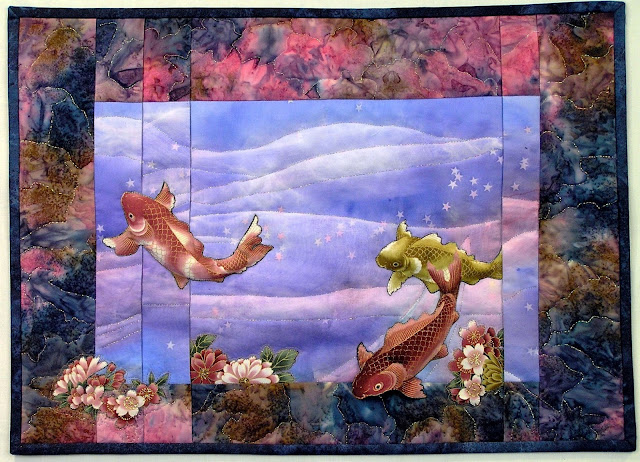Quilt No. 121
December 2017
Cubist Phase is a bit of a departure from my usual quilting
projects. It came about because I simply
could not resist the lure of something called a “One Block Wonder”. I’d heard of “boy wonders” and “Wonder Bread”
and grew up with “The Wonderful World of Disney”, so anything steeped in wonder
gives me goose bumps.
For this quilting method, the claim of being a one block
wonder is valid. All the blocks,
including the cube shaped ones, are the same in terms of their shape, so there’s
just the “one block”. But really, the
“one block wonder” moniker misses the most exciting attribute of this quilt –
all the blocks (excluding the cubes, which are optional) are made from only one
fabric. So it’s really a “One Fabric Wonder”
quilt. The quilt is made up of a whole
field of blocks, all from the same fabric, and no two of these blocks are the
same. Surely magic is involved?
The quilt is constructed by lining up multiple layers of
fabric so that the pattern is perfectly aligned in each of six layers. That is, the bird in layer 1 is in the exact
same location as the same bird in layer 6.
Where to go from there is far from obvious. Like learning meditation or heart surgery, you
need someone who knows more than you do to show you the way. That person must guide you down the path that
involves cutting these carefully aligned layers into strips and then cutting
those strips into triangles, and ending up with something that ultimately turns
into a quilt.
Despite my fondness for reverse engineering, I know I would
be stymied if I tried to unravel how to construct this by merely looking at a
finished quilt. The whole quilt appears to be composed of hexagon shapes, but no
actual hexagon-shaped individual blocks are ever sewn together for this
quit. Wah? Half hexagons only get upgraded to full
hexagons when neighbouring strips are sewn together. For this journey, I had to have faith, allow
the rules to dictate my actions, enslave myself to obedience. I had to suppress my natural tendency towards
rebellion. I had to soothe myself with
chocolate, drink only decaff, and keep a cold compress handy for my forehead.
 |
| Original fabric prior to cutting for One Block Wonder |
This quilt also requires patience if you are inclined to be
motivated by the creative aspects of making a quilt. With One Block Wonder, the creativity comes
in the later phases when you start auditioning layouts for the blocks that form
the hexagons you see. It’s a waiting
game. Stamina is imperative.
I learned this procedure at guild meetings and a
workshop. For your own guided tour,
Jackie O’Brien’s step-by-step
videos will have you one block wondering
in no time.
I wanted to keep at least some of the birds and flowers from
the original fabric visible as part of the quilt, so I’ve captured some of
these “whole” objects on the border with raw edge applique.
“One Block Wonder” or “One Fabric Wonder”? This quilting technique is definitely both!


